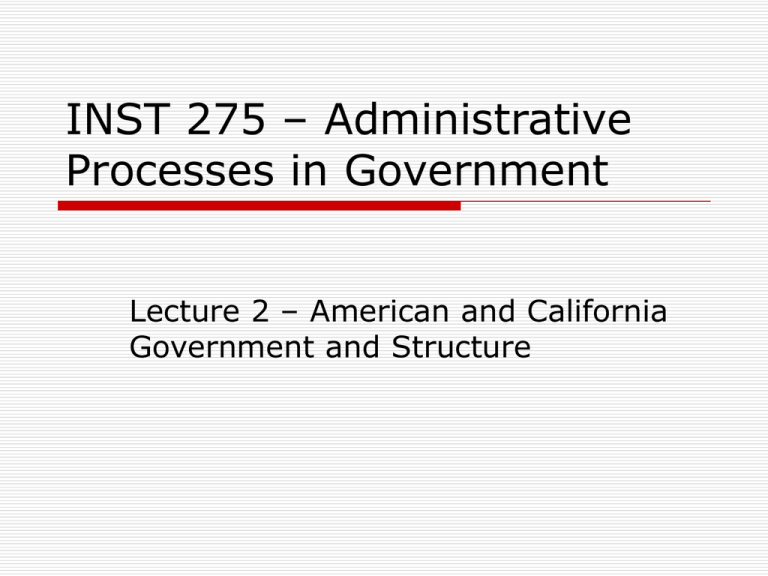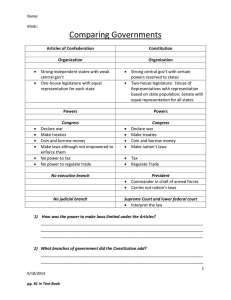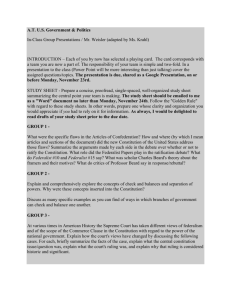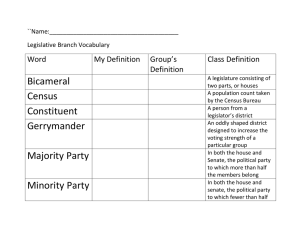INST 275 – Administrative Processes in Government
advertisement

INST 275 – Administrative Processes in Government Lecture 2 – American and California Government and Structure Origins of American Government Governments are the vehicles through which policies are made and affairs of state are conducted. Citizens, by law, are members of the political community who by nature of being born in a particular nation or having become a naturalized citizen are entitled to all of the freedoms guaranteed by the government. Politics is the study of who gets what, when, and how or the process of how policy decisions are made. Functions of Government – “To Form a More Perfect Union” Establishing justice. System of laws with common principles. Ensuring domestic tranquility. Homeland security, FBI, police forces. Providing for the common defense. Department of defense. Promoting the general welfare. Currently a significant portion of the federal budget. Securing the blessings of liberty. Civil liberties and civil rights. Types of government Artistotle's Classifications of Government In Whose Interest? Public Self Rule by: One The Few The Many Monarchy Tyranny Aristocracy Oligarchy Polity Democracy Roots of American Government American political system is based on several principles that have their roots in classical Greek ideas. Social contract theory. Hobbes – government is necessary to produce security – “life is solitary, poor, nasty, brutish, and short” without government – Single ruler no matter how evil. Locke – government is necessary to protect life, liberty, and property. Government is limited. Representative democracy. American Political Culture Personal liberty. Equality. Popular consent and majority rule. Popular sovereignty. Individualism. Religious faith. Changing Demographics of the U.S. Population Changes in racial and ethnic composition. 1967 – 23.7% nonwhite, 76.6% white. 2006 – 43.4% nonwhite, 56.6% white. Changes in age cohort composition. When the U.S. was founded, the average life expectancy was 35 years. By 2006, it was 80 for women and 75 for men. Change in family and family size. 1940 – 90% traditional families (both parents). 2004 – 68% traditional families. Political Ideology: Its Role in the World and American Politics Political ideology – The coherent set of values and beliefs about the purpose and scope of government held by groups. Libertarian – One who favors a free market economy and no governmental interference in personal liberties. Conservative – One who believes that a government is best that governs least and that big government can only infringe on individual, personal, and economic rights. Social conservative – One who believes that traditional moral teachings should be supported and furthered by the government. Liberal – One who favors governmental involvement in the economy and in the provision of social services and an activist role in protecting the rights of women, the elderly, minorities, and the environment. Sources of ideology. Genetics – identical and fraternal twins studies. Political socialization – early childhood development. Current Attitudes toward American Government High expectations. A missing appreciation for the good. Mistrust of politicians. Voter apathy. Redefining our expectations. Origins of the New Nation Most early settlers remained loyal to Great Britain and considered themselves subjects of the King. Later generations born on American soil weakened the ties. A series of taxes levied by the Parliament and Crown led colonist to convene a Continental Congress and declare independence. The Articles of Confederation Articles of Confederation (1781) created a loose league of friendship between the new national government and the states. Numerous weaknesses. Inability to tax. Inability to regulate commerce. Absence of an executive. Lack of a strong central government. No judiciary. Writing a Constitution When weaknesses became apparent, states called for a convention to fix them. The convention threw out the Articles and wrote a new constitution. Series of compromises. Representation. Small versus large states (Senate and House). Determination of population (3/5 rule). Members of each branch selected differently. House – Direct Election Senate – Appointment by state legislature. President – Electoral college. U.S. Constitution Continuum – Unitary, Federal, Confederal. Themes of Constitution. Popular sovereignty. Representative government. Limited government. Separation of powers (Montesquieu). Checks and balances. Division of powers (federalism). Federal supremacy. Judicial review. Drive for Ratification Fight between Federalists and AntiFederalists. Federalists (Hamilton) – Strong national government; Anti-Federalists (Jefferson) – Greater state power. Methods for Amending the Constitution Formal. Proposal. 2/3 vote of each House of Congress. 2/3 vote of state legislatures calling for national convent (never). Ratification. ¾ vote of state legislatures. ¾ vote of state conventions (once). Informal. Judicial interpretation. Social and cultural change. Origins of Federalism National and state governments have both enumerated and implied powers under the Constitution. National and state governments share some concurrent powers. Other powers are denied to both, although national government is supreme. Constitution makes Supreme Court arbiter for disagreements among states. Federalism and the Marshall Court Over the years, power of the federal government has increased at expense of states. Necessary and proper clause. Interstate commerce clause. Supremacy clause. Dual Federalism: The Taney Court, Slavery, and the Civil War For many years, dual federalism tended to limit federal power in areas like slavery and civil rights. Peak of dual federalism: Dred Scott versus Sandford (1857). One of the precipitating events of the Civil War. Sixteenth and Seventeenth Amendments marked a change in focus. Cooperative Federalism: The New Deal and the Growth of National Government. The Depression and the New Deal caused a shift away from the concept of limited government. Growth of size and role of federal government accelerated under Lyndon Johnson and Richard Nixon. Federal grants became population solutions to state and local problems. New Federalism: Returning Power to the States? Ronald Reagan attempted to shrink size and power of the federal government through New Federalism. Campaign continued through the 1990s, culminating in the Contract for America. George W. Bush administration initially committed to reduction, but September 11 greatly increased national authority. Evolution of State and Local Governments. Initial intent was to limit scope of state and local governments. Complexity of society and economy and court rulings on representation have changed this. Trend since 1960s has been for more representative and more professional state and local governments. More policy implemented by partnerships with feds, other states, and private sector. State Governments State governments have had primary responsibility for: Criminal justice. Education. Public health. Economic development. Increased role in: Welfare policy. Environmental policy. State constitutions provide the basic framework of institutions and values that allow state governments to act. Since the 1960s, these governments have become more professional and competent. Local Governments. Local governance conducted by collection of over 87,000 units of government, most run by part-time officials. All need charters to run. Dillon’s rule versus home rule. Range from counties, towns, municipalities, to special districts. Most common structures. Mayor – council (strong and weak). Council – Manager (Superintendent – school board). Commission (Supervisors). Grassroots Power and Politics Those with the most influence over the making and implementation of policy are not always the ones in formal office. A family, a business, small group of individuals, or the local media. Governance at the grassroots is face to face, between neighbors, friends, and former high school classmates. Relations with Indian Nations American Indian nations affected and are affected by state and local government. Due to treaty rights and the domestic dependent sovereignty of tribes, Indian nations have a special relationship with the Feds. Tribes have important protections against actions by state and local governments. Conversely, their special status creates challenges for consistent and coherent policies in states and localities. Currently, Feds are urging tribes to move to selfdetermination and make agreements with state and local governments on financial and policy matters. State and Local Finances Funding government is complex. Revenues are hard to project because governments tax personal and business incomes, sales, and property value over which the governments have no control. State, local, and tribal governments also rely heavily on money given to them by other jurisdictions, including the federal government. The challenge is, given these uncertainties and the general hostility toward taxes, to budget for required services and popular programs. Bill of Rights 1st Amendment. Freedom of Religion. Establishment clause. Free exercise clause. Freedom of Expression. Speech. Press. Assembly and Petition. 2nd Amendment – Right to Keep and Bear Arms. Bill of Rights Rights of Criminal Defendants. 4th Amendment – Searches and Seizures 5th Amendment – Grand jury, due process, selfincrimination, double jeopardy Exclusionary rule. 6th Amendment – Speedy and public trial, trial by jury, confrontation of witnesses, right to counsel. 8th Amendment – Excessive bail and fines, cruel and unusual punishment. The Constitution and the Legislative Branch of Government Bicameral – U.S. House of Representatives & U.S. Senate elected differently. Article I sets qualifications, age minimums, and distribution among states. House apportioned by population (currently 650,000 per district). In Senate, each state has two senators. Reapportionment and redistricting. Lay and collect taxes and duties, borrow money, regulate commerce, naturalization, bankruptcy, coin money, fix weights and measures, punish counterfeiting, establish post office, issue patents and copyrights, define and punish piracies etc., create inferior courts, declare war, raise and govern an army and navy, provide a militia (with states), exercise power over federal property and facilities, make laws necessary and proper for carrying out the former. Congress has enumerated and implied powers. How Congress Is Organized 435 Representatives, 100 Senators. Parties are important to structure. Speaker from majority party. Majority party structures Congress. Committees and subcommittees conduct most significant business. All legislators serve on one or more. Members of Congress MC’s live in two worlds, home style and hill style. Reelection key motivation. Incumbency is important. How Members Make Decisions Ideology a key factor. Other factors include party, constituents, colleagues and caucuses, staff and support agencies; interest groups, lobbyists, and PACs. The Law-Making Function Only a small percentage of bills become law (less than 10%). Legislation must be approved by subcommittees, committees, by both houses, conference committees, by both houses again, and the President (who can sign, not sign, or veto). Congress and the President Framers intended for Congress and President to have discrete spheres of influence. Power has shifted to President. However, Congress has oversight authority, budget authority, War Powers Act (ineffective), Senate approval of appointments, impeachment. Congress and the Judiciary Size of court. Appellate jurisdiction. Structure of federal court system. Senate approval of nominees. Origins of Presidency Constitution created a president with limited power (persuasion). 35, natural-born citizen, resident of U.S. for at least 14 years. Did not limit terms initially (22nd amendment, two terms). Provided provisions for removal (impeachment). Constitutional Powers of President Appointment. Convene Congress. Make treaties. Grant pardons. Veto acts of Congress. Commander-in-Chief. Development and Expansion of Presidential Power Depends on personality and interests of incumbent. Early presidents let Congress dominate (exceptions Washington, Jefferson, Lincoln). FDR marked increase in presidential power and presidents have been more important in national and foreign affairs. The Presidential Establishment Executive Office of the President (especially OMB, NSC, White House Staff). Primary advisers. Vice president, White House staff, some members of EOP, the First Lady. President as Policy Maker Since TR, Wilson, and FDR, Congress expects presidents to initiate legislation. Propose legislation, advance budgets, and involvement in regulatory process. Presidential Leadership and the Importance of Public Opinion To gain support for programs, Presidents use a variety of skills, including personal leadership and direct appeals to the public. Determined by leadership and personal style, character and ability to persuade. Increased public skepticism has reduced honeymoon period and flexibility. Crisis in California Politics The two-thirds requirement for passing the state budget. Interest group impasse. Term limits. Safe seat reapportionment. Content and Character of California Politics Underlying socioeconomic trends. Population growth. Race and ethnicity. Aging. Education. Mobility and foreign-born population. Income. California Constitution Adopted in 1849 and revised several times. Four stages: 1849 Constitution established the basic structure of government including separation of powers, bicameralism, federalism, and popular election for most state offices. 1879 constitution added nine new articles and 8,000 words (corporate restrictions, restrictions on Chinese immigrants). Progressive era (1910-1917). Initiative, referendum, and recall. Hundreds of reform laws. Constitutional Revision Commission. Legislature. Initiative. 1960 to the Present. California Constitution Amendment. Constitutional convention (2/3 vote of legislature or majority vote of population). Constitutional initiative. Legislative proposal (2/3 vote). Approval by majority vote of electorate. Progressive Reformers Put an end to dominance of big corporations (especially Southern Pacific Railroad). Reform corrupt political parties. Remove corrupt politicians. Return government to people. Address social problems (child labor, environment, state parks, working people). Legacies. Nonpartisan elections. Primary elections. Office block voting. Direct democracy. California Legislature Assembly (80 members), Senate (40 members). Some of the largest election districts in the world. Both houses apportioned by population. Legislators must represent constituents and make policy. Not always linked. Poor communication makes representation difficult. California Legislature California once had one of most professional legislatures of all states. Term limits reduced expertise. Most legislators now less experienced than bureaucracy and lobbyists. 863,000 constituents for senators and 431,000 for Assembly. Gerrymandered and safe. Majority party controls both houses. Speaker dominates assembly. President pro tempore and Senate Rules Committee dominate the Senate. California Legislature Bulk of legislative work done in committees and subcommittees. Helped by professional staff. Bills introduced by legislators and sent to committee. Like Congress, requires identical bills to go to Governor. Majority vote except veto overrides, budget bills, appropriation bills, and tax bills. Differences from Congress Term limits. Line-item veto. Both houses based on population. No filibuster. Initiative process. Effectiveness limited by term limits and lack of experience, 2/3 vote rule. California Governor Modeled after president, but some differences. Head of state and head of government. Governor has less access to media. Has line item veto, but many cabinet offices are elected separately. Governor has limited powers. Legislature, judiciary, other elected executive officers, and the permanent executive branch. California Governor Formal powers include appointment, organizing executive branch, instigating independent executive actions allowed by law, commander-in-chief, budget proposal, legislative recommendations, veto power. Public roles include ceremonial, bill signing, dealing with natural disasters, campaigning and fund-raising, and advocating initiatives. Structure of State Government under Governor Governor’s staff. Cabinet. 85 departments. 300 boards and commissions. 300,000 full-time employees. Elected executives. Lieutenant governor, attorney general, secretary of state, controller, the treasurer, the superintendent of public education, insurance commissioner, state Board of Equalization.








